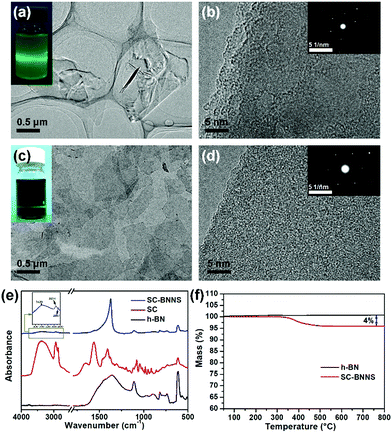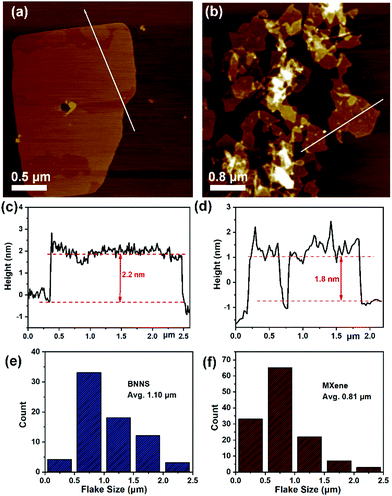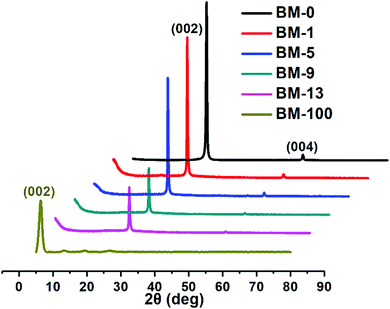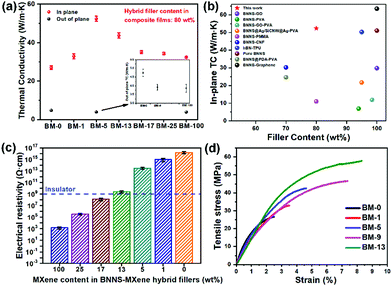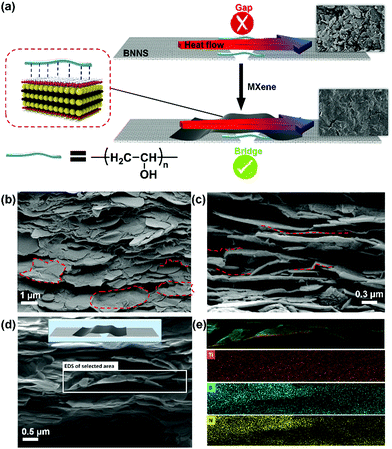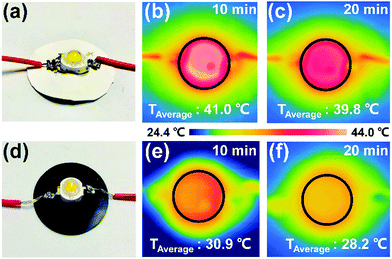A small amount of delaminated Ti3C2 flakes to greatly enhance the thermal conductivity of boron nitride papers by assembling a well-designed interface†
Xianwu
Huang
a and
Peiyi
Wu
 *ab
*ab
aState Key Laboratory of Molecular Engineering of Polymers, Department of Macromolecular Science and Laboratory of Advanced Materials, Fudan University, Shanghai 200433, China
bState Key Laboratory for Modification of Chemical Fibers and Polymer Materials, College of Chemistry, Chemical Engineering and Biotechnology, Center for Advanced Low-Dimension Materials, Donghua University, Shanghai 201620, China. E-mail: wupeiyi@dhu.edu.cn
First published on 2nd December 2019
Abstract
The rapid development of electronic equipment has led to stricter requirements for thermal management materials. Traditional polymeric composites cannot satisfy these demands due to their low thermal conductivity (TC). The rapid development of two-dimensional (2D) nanomaterials with high intrinsic TC provides us with a new avenue to prepare highly thermally conductive composites. In our work, small amounts of exfoliated Ti3C2Tx nanosheets were chosen to cooperate with boron nitride nanosheets to fabricate hierarchically layered composite films by vacuum-assisted filtration. We found that small amounts of Ti3C2Tx reform the in-plane TC of the composite film. Our experimental results show that when the mass content of Ti3C2Tx in the hybrid fillers is 5%, this composite film possesses an exceptionally high in-plane thermal conductivity up to 52.4 W m−1 K−1 and still maintains the favorable electrical insulating property. Besides, more interestingly, the small addition of Ti3C2Tx can simultaneously improve the tensile strength and the fracture strain of the film. We attribute the enhancement of thermal-conducting performance to the well-designed interface assembled by MXene. Therefore, this freestanding composite film has immense applied value in highly integrated electronic devices.
Introduction
The high-degree integration and miniaturization of electronic equipment have simultaneously led to stricter requirements on the heat-conducting and electrical insulating properties of thermal management materials, which are essential for the performance and lifetime of electronic devices.1–5 Traditional polymeric composites cannot meet these demands due to their low thermal conductivity (TC) (0.1–0.3 W m−1 K−1). The rapid development of two-dimensional (2D) nanomaterials with high intrinsic TC and TC anisotropy provides us with a new platform to prepare highly thermally conductive composites.6,7 Recently, boron nitride nanosheet (BNNS), as an important member of the 2D material family, is a promising candidate to prepare thermally conductive yet electrically insulating composites, owing to its high TC, strong resistance to oxidation, wide band gap (about 5.9 eV), and low dielectric constant.8–15 Among these composites, anisotropic BN-related composite films with a hierarchically layered structure are a research hotspot.16–18 Considering the extreme brittleness of pristine BNNS films, the previously-reported works usually used some polymers or macromolecules as the inter-layered binder, such as polyvinyl alcohol (PVA),19 natural rubber (NR),20 epoxy (EP),21,22 and cellulose nanofiber8,23 to improve their mechanical property and structural integrity. However, the large interfacial thermal resistance (ITR) caused by the poor contact between adjacent BNNSs always leads to a low in-plane TC of these composite films (<10 W m−1 K−1), which fails to satisfy the requirements of modern start-of-the-art electronic devices. Therefore, the design of the thermal-conducting interface also plays a crucial role in the further enhancement of thermal conductivity.Recently, some studies have verified that introducing secondary filler such as silver nanoparticles (AgNPs),22 silicon carbide nanowires (SiCNWs),24 carbon nanotubes (CNTs),25 graphene oxide (GO)26 and graphene27 into the BN-based composite films can significantly improve their thermally conductive performance. Among these secondary fillers, although zero-dimensional (0D) and one-dimensional (1D) fillers can act as a bridge to link the isolated BNNSs, leading to a more continuous heat-conduction pathway,28 the insufficient contact area between 0D or 1D secondary fillers and BNNSs still has limitations in reducing the ITR significantly. By contrast, two-dimensional (2D) fillers are more suitable to be the secondary filler because they can form tight “face-to-face” contact with BNNSs, and thus pad the gaps between adjacent BNNSs, which can decrease the thermal contact resistance and provide high-flux heat conduction. As a 2D material with excellent thermal conductivity, it is natural for us to pick graphene. However, because of the absence of oxide-containing groups, it is difficult for graphene to well disperse in many polar solvents.29 In contrast to graphene, GO has abundant oxide-containing groups, which enables it to be homogenously dispersed in water. However, its poor intrinsic thermal conductivity has limited the further enhancement of the thermal-conducting performance of composite films. Therefore, the ideal 2D secondary filler is expected to possess high intrinsic thermal conductivity and excellent dispersibility simultaneously.
In 2011, MXenes were firstly discovered by Gogotisi and co-workers.30 Nowadays, these novel 2D nanomaterials have been widely used in electrocatalysts,31 Li-ion batteries,32 NIR-induced photo-thermal therapy,33 electromagnetic interference absorption,34,35 water treatment,36 and electrochemical storage systems.37,38 In fact, MXene was also utilized to prepare thermally conductive composites.39 For instance, recently, Liu et al. reported thermally conductive polybenzimidazole composites containing BNNS and MXenes,40 where the selected MXene is a multiple-layer MXene rather than a delaminated single thin nanosheet, and it is thus hard to exert the high intrinsic thermal-conducting capacity of the 2D nanosheet. Moreover, excessive addition of highly electrically conductive MXene would reduce the volume resistance, which can’t meet the demand of modern sophisticated electron devices. Similar to the physical properties of graphene, 2D MXene nanosheets have outstanding electrical conductivity, mechanical properties and thermal conductivity.41,42 More importantly, the existence of abundant active terminal groups such as –O, –F, and –OH makes the MXenes easier to disperse in most of the solvents without any modification, which is inaccessible for graphene.43–45 This inspired us that 2D few-layer MXene nanosheets with high intrinsic in-plane TC might be the ideal secondary fillers to cooperate with BNNSs. We anticipate that small amounts of flexible MXenes can link adjacent BNNSs to reduce the ITR, forming continuous heat-conducting pathways, which will accomplish the goal of the well-designed interface. Meanwhile, the in-plane orientation among BNNSs is likely to be significantly promoted owing to the repulsive forces generated by the MXene.26 In this case, the heat dissipation of the network linked by MXene could permeate among a larger area of the in-plane interface rather than the tanglesome BNNS-to-BNNS interface. Besides, due to the abundant surface functional groups, the MXene can form strong hydrogen bonds with macromolecules, leading to favorable mechanical properties.46,47 Some studies have also found that the localized surface plasmon resonance effect provides MXene with remarkable light-to-heat conversion efficiency (100%).33,48 Hence, the introduction of MXene may endow the composite film with versatility.
In this work, as expected, we found that a slight amount addition of Ti3C2Tx can effectively boost the in-plane TC of BNNS composite papers. The obtained TC is much higher than that of most reported BN-related films. Meanwhile, owing to the existence of only a spot of MXene, the prepared composite films still represent favorable electrical insulation properties. Moreover, we demonstrate that small amounts of Ti3C2Tx also improved the tensile strength and the elongation at break of the film simultaneously. The enhancement of the in-plane TC can be ascribed to the highly ordered orientation and the well-designed interface assembled by synergistic BNNS/MXene. These outstanding properties make the composite films possess huge application potential for next-generation flexible electronic devices. Furthermore, this study provides a guided thought for constructing thermally conductive and electronically insulating composites.
Experimental section
Materials
Isopropanol (IPA) and hydrochloric acid (HCl) were purchased from Shanghai chemical Corp. The polyvinyl alcohol with a molecular weight of 145![[thin space (1/6-em)]](https://www.rsc.org/images/entities/char_2009.gif) 000 was purchased from Shanghai Aladdin Bio-Chem Technology Co., Ltd. Lithium fluoride (LiF) (AR, 99%) and sodium cholate (SC) were purchased from Shanghai Macklin Bio-Chem Technology Co., Ltd. The hexagonal BN (h-BN) was purchased from Alfa Aesar. Ti3AlC2 with the average particle size of 200 meshes was purchased from Jilin 11 Technology Co., Ltd. Deionized water (DI H2O) was utilized for all experiments.
000 was purchased from Shanghai Aladdin Bio-Chem Technology Co., Ltd. Lithium fluoride (LiF) (AR, 99%) and sodium cholate (SC) were purchased from Shanghai Macklin Bio-Chem Technology Co., Ltd. The hexagonal BN (h-BN) was purchased from Alfa Aesar. Ti3AlC2 with the average particle size of 200 meshes was purchased from Jilin 11 Technology Co., Ltd. Deionized water (DI H2O) was utilized for all experiments.
Preparation of BNNSs/H2O dispersion
BN nanosheets were prepared via surfactant-assisted exfoliation from h-BN powders in deionized water with a tip-type sonication process.49,50 Typically, 4.0 g of h-BN powder and 400 mL 0.05 wt% SC aqueous solution were mixed well by bath sonication (KQ5200DB) with an output power of 250 W for 30 min. Then, the well-homogenized solution was subjected to tip-type sonication (HN-1000Y, 1000W) for 2 h. Finally, the BNNS/H2O dispersion (1.2 mg mL−1) can be obtained by centrifugation for 30 min at 1500 rpm.Synthesis of delaminated Ti3C2Tx
The delaminated Ti3C2Tx (d-Ti3C2Tx) was synthesized by selectively etching Al from the Ti3AlC2 (MAX) phase by LiF/HCl followed by ultra-sonication. Typically, 2 g of LiF was dissolved in 40 mL 9 M HCl in a polypropylene plastic container under magnetic stirring for 5 min, after which 1.98 g Ti3AlC2 was added slowly to the etchant solution in 5 minutes cooling with an ice-water bath. The mixture was allowed to proceed at 35 °C for 24 h. The resultant acidic dark mixture was washed by DI H2O several times via centrifugation at 3500 rpm for 5 min per cycle, and then the clay-like multilayer-Ti3C2 was obtained once the pH of the supernatant exceeded 6. Adding 100 mL DI H2O to the dark clay and bath sonication for 1 h with inert-gas protection led to delamination of the m-Ti3C2. After centrifugation for 1 h at 3500 rpm, the dark green uniform supernatant was exactly the delaminated Ti3C2Tx MXene dispersion. The concentration of MXene dispersion was determined by filtration of an accurately known volume.Fabrication of BNNS@MXene-PVA hybrid film
The hybrid films were prepared through a simple but effective process (i.e., Vacuum-assisted filtration self-assembly (VAFSA) process). Typically, the as-prepared BNNS dispersion and MXene dispersion were added to an aqueous PVA solution. In this work, the mass percent of PVA in the composite film was controlled to be 20%, which endows the composites with excellent film-forming and mechanical properties. The mixture was sonicated for 20 min, and then the uniform dispersion was filtered through a cellulose acetate membrane with a pore size of 0.22 μm. The BNNS@MXene composite films were peeled off after being dried at 45 °C in a vacuum for 24 h. It should be noted that the total mass of BNNS@MXene hybrid fillers was fixed to be 30 mg. The hybrid fillers containing X wt% of MXene were donated as BM-X (X = 0, 1, 5, 9, 13, 17, 25, and 100).Characterization
The microstructures and morphology of the BN and Ti3C2Tx nanosheets were observed by transmission electron microscopy (TEM, JEOL JEM2011 F Microscope) operated at 200 kV and atomic force microscopy (AFM, Bruker Multimode 8). Scanning electron microscopy (SEM, Zeiss Ultra 55 with EDX) was utilized to examine the morphology of the raw materials and obtained composite films. The crystalline structures of BNNS and MXene were examined by X-ray powder diffraction (XRD, X’pert PRO PANalytical) with Ni-filtered Cu Kα radiation (40 kV, 40 mA). The tensile curve was obtained on a universal electronic tensile machine (SUNS, UTM 4000). A Zetasizer Nano-ZS90 was used to investigate ζ-potential. A Nicolet Nexus 470 spectrometer was used to collect the Fourier transform infrared (FTIR) spectra. The volume resistivity of these films was measured on a double testing digital four-probe tester (JG, ST2263). A differential scanning calorimeter (DSC, TA Q2000) was used to measure the specific heat (c, J g−1 K−1) via the three-step method based on sapphire. The density (ρ, g cm−3) of the composites was worked out from the known mass and measurable volume. A laser-flash diffusivity instrument (LFA 447, NETZSCH) was utilized to examine the in-plane thermal diffusivity (α, m2 s−1) of the composite papers. The samples for testing needed to be tailored into a circle 25 mm in diameter. Eventually, the thermal conductivity (λ, W m−1 K−1) was calculated via this equation: λ = α × c × ρ.Results and discussion
Fig. 1 schematically shows the typical preparation process of the BNNS@MXene/PVA composite film. The h-BN and bulk MAX were primarily exfoliated into few-layered BNNSs and MXenes, respectively, as shown in Fig. 1a. A uniform free-standing composite film can be obtained by filtrating the homogeneous dispersion of BNNSs, MXenes, and PVA (Fig. 1b).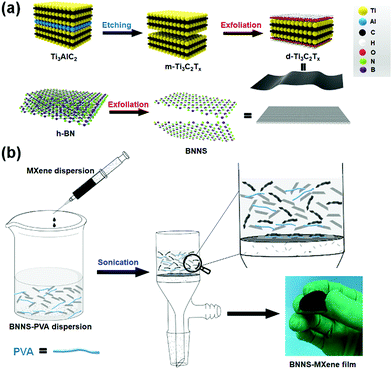 | ||
| Fig. 1 Schematic illustration of the preparation process of (a) d-Ti3C2Tx, BNNS, and (b) BNNS-MXene composite paper. | ||
Many research studies demonstrate that sodium cholate (SC) can assist the reliable exfoliation of h-BN into few-layered BNNSs in water owing to the amphiphilic nature of SCs and strong affinity between BNNSs and SCs (Fig. S1, ESI†).49–51 After centrifugation, the collected BNNS aqueous suspension shows a uniform colloidal system with a clear Tyndall effect (Fig. 2a). TEM was performed to study the morphology of the exfoliated BNNSs. As shown in Fig. 2a, the obtained BNNSs with a lateral size above 1.0 μm exhibit a transparent and curly lamellar structure under the electron beam, indicating their ultrathin feature. The obvious and regular crystal lattices were observed via high-resolution TEM (HRTEM) and its corresponding selected area diffraction pattern (Fig. 2b inset) manifested the hexagonal crystal structure, indicating that the exfoliated BNNSs maintain the structural integrity of h-BN. On the other hand, MXene flakes are easily oxidized with the coexistence of oxygen and water especially under the high-temperature environment.52 Therefore, in this work, before the bath sonication, the multilayer-MXene dispersion was bubbled with an inert gas for 0.5 h and immersed into an ice bath to avoid oxidation during the sonication treatment. Moreover, the fresh as-prepared MXene dispersion would be put to use immediately. The TEM and HRTEM images of the exfoliated 2D MXene also show an ultrathin lamellar morphology with an average lateral size of approximately 1 μm and well-defined hexagonal crystal structure.
To confirm the structural evolution of h-BN and Ti3AlC2 before and after exfoliation, the XRD patterns of the raw h-BN, BNNSs, bulk MAX, and MXenes were all collected. In Fig. S2 (ESI†), the characteristic diffraction peaks of h-BN appeared at 2θ = 26.5, 41.5, and 55.2°, which are assigned to the (002), (100) and (004) lattice plane. After exfoliation, the intensity of the (002) lattice plane shows a significant increase, and the intensity of the (100) diffraction peaks of the BNNSs nearly disappeared, demonstrating the successful exfoliation of h-BN into few-layered BNNSs. On the other hand, the (104) characteristic peak of Ti3AlC2 disappears and the (002) diffraction peak shifts from 9.5° to 6.5°, indicating the transformation of Ti3AlC2 phase (Fig. S3a, ESI†) to Ti3C2 (Fig. S3b–d, ESI†) and the further exfoliation to MXene, respectively. Furthermore, FTIR and TGA were performed to attest the non-covalent functionalization of BNNS by sodium cholate (SC-BNNS). In Fig. 2e, the FTIR spectrum of SC-BNNSs displays the characteristic absorption bands of SCs at 3420 (–OH stretching), 2934, and 2867 cm−1 (–CH stretching), indicating the successful non-covalent functionalization of BNNS via van der Waals forces. The TGA curve reveals that the raw h-BN is thermally stable, whereas the mass loss of SC-BNNS is 4%, further supporting that the quantity of SCs is approximately 4% in the SC-BNNSs.
AFM was applied to evaluate the thickness of these exfoliated 2D nanosheets. According to Fig. 3a–d, the thickness of the exfoliated BNNS and MXene was measured to be approximately 2.2 nm and 1.8 nm, respectively. Based on the size statistical distribution according to AFM and TEM images, the average flake size of the BNNS and MXene nanosheets was 1.10 μm and 0.81 μm, respectively.
In the following procedure, the BNNS/MXene-PVA ternary composite films were successfully prepared via VAFSA. It is well known that a well-dispersed precursor solution is an indispensable factor to gain a uniform freestanding composite film. In this regard, the ζ-potential (Table S1, ESI†) of exfoliated BNNSs and MXene in DI water is measured to be −20.1 mV and −39.0 mV, respectively. Thus, the repulsive forces generated by surface abundant charged groups among MXenes could provide stability for BNNSs in the hybrid dispersion.26 The images of energy disperse spectroscopy (EDS) (Fig. S4, ESI†) indicate the uniform distribution of two representative elements B and Ti, demonstrating that MXene nanosheets are distributed evenly within this ternary paper.
The morphology of three typical composite films was investigated by field emission scanning electron microscopy (FESEM). Fig. 4a–i exhibit the digital photograph, surface and cross-sectional microstructure of BM-0, BM-1, and BM-5, respectively. According to the previous-reported work concerning PVA-based thermally conductive composites, it has been thoroughly investigated how the mass fraction of PVA affects the final TC and mechanical property.19,47 In this work, we pay much attention to the influence of the secondary filler (MXene). Thus, when no MXenes are added, the surface of the BM-0 film shows distinct air gaps between adjacent BNNSs (Fig. 4b). The fractured cross-section shows the long-range disorder and no distinct orientation along the in-plane direction in Fig. 4c. On the increasing addition of MXene, the BM-1 film changes from white to gray in appearance (Fig. 4d), and Fig. 4e reveals that a small amount of flexible MXenes covers up most of the gaps on the surface, which is similar to the “mortar-to-brick” structure. Nevertheless, some visible air gaps still exist between these adjacent nanosheets. Simultaneously, BM-1 film also fails to show a highly ordered in-plane orientation (Fig. 4f). In striking contrast, when the mass fraction of MXene is up to 5% in the hybrid fillers, almost all of the gaps on the surface are padded by flexible MXene nanosheets (Fig. 4h). Moreover, long-range highly ordered orientation and the well-packed layer-by-layer (LBL) microstructure are indeed observed as shown in Fig. 4i, indicating that the small amount of MXene added is not only able to link tanglesome BNNSs but also regulates the degree of orientation and packing.
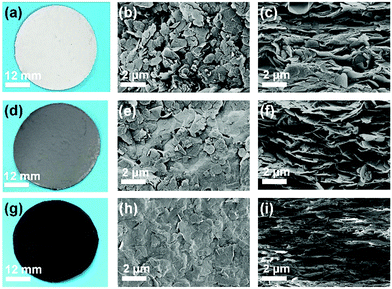 | ||
| Fig. 4 (a, d and g) Digital photograph of BM-0, BM-1 and BM-5 paper. SEM images of the (b, e and h) surface and (c, f and i) cross-section of BM-0, BM-1 and BM-5 paper. | ||
The XRD patterns of the prepared composite films are depicted in Fig. 5. Two characteristic peaks of (002) and (004) reflections can be observed in the BM-0 film at 2θ = 27.0 and 55.1°, respectively. It is worth noting that the characteristic peaks of the (110), (101), and (102) lattice plane at 2θ = 41.6, 43.9, and 50.2° nearly disappear in contrast to the XRD pattern of h-BN in Fig. S2 (ESI†), indicating the excellent orientation along the in-plane direction via VAFSA as well as the successful exfoliation from h-BN. The (002) characteristic peak of MXene shifts from about 6.5 (Fig. S2, ESI†) to 6.0° while incorporating with PVA, suggesting that PVA can intercalate the adjacent lamellas of MXene and thus enlarge the d-spacing.47,53 However, the characteristic peaks of (002) reflections of MXene do not appear above 2θ = 5° when MXenes act as the second filler. This observation could be explained by the presence of plentiful strong crystallinity BNNS covering up the characteristic diffraction peaks of MXene nanosheets.
The in-plane TC is a crucial parameter to judge a flexible thermally conductive film. Therefore, the laser-flash (LFA) method was performed to measure the in-plane TC of these composite films. Fig. 6a displays the in-plane TC of composites films with different content of MXene in the hybrid fillers. The detailed density, thermal diffusivity, and specific heat are listed in Table S2 (ESI†). Previous works have reported that pristine BN film possesses a low TC because of the existence of the gap and disordered stacking.19 When a small amount of PVA was added, long-chain PVA could pad the gap and bridge the isolated BN nanoplates, leading to the improvement of the in-plane TC.19,54 Nevertheless, as shown in Fig. 4b, there remain lots of distinct air gaps and cracks in the surface. So, when no MXene was added, the in-plane TC of the BM-0 film is measured to be approximately 26.0 W m−1 K−1. Moreover, when MXene replaced all of the BNNSs, the in-plane TC of the BM-100 film is about 32.4 W m−1 K−1. The resulting TC of the MXene/PVA film with 20 wt% PVA is similar to a reported work,53 in which the in-plane TC was measured to be about 47.3 W m−1 K−1 when the mass fraction of PVA is 12.71%. However, the in-plane TC of the BM-5 film can reach up to the highest value of 52.4 W m−1 K−1 almost 200% of that of the BM-0 film and 160% of that of the BM-100 film, meanwhile, outperforming other BNNS/MXene composite films. So, the optimal number value of MXene in the hybrid fillers is confirmed to be 5 percent. On the other hand, the theoretical thermal conductivity of a single boron nitride nanosheet (BNNS) can reach an ultrahigh value of 2000 W m−1 K−1,55 but Ti3C2 flakes possess a lower theoretical thermal conductivity of 50 to 500 W m−1 K−1.56 The small amount of Ti3C2Tx flakes introduced can fill the interspaces left by BNNS and thus reduce the thermal interface resistance. However, when the MXene content is above 5 wt%, the excessive stacking of MXene flakes packed on the BNNSs would restrain the transfer of phonons between adjacent BNNSs, resulting in a decrease in TC. Therefore, there exists an apparent synergistic effect between a small amount of MXenes and BNNSs to enhance in-plane thermal performance. But, when the addition of MXenes increased, the out-of-plane TC was slightly decreased from 4.7 (BM-0) to 3.92 (BM-5) W m−1 K−1, which can be ascribed to the improvement of in-plane orientation and thus the thermally conductive pathways in the out-of-plane direction were reduced.
Fig. 6b shows the comparison of the optimal in-plane TC between the BNNS/MXene composite film and other reported BN-related composite films or papers like BNNS-GO,26 BNNS-PVA,19 BNNS-GO-PVA,57 BNNS@Ag/SiCNW@Ag-PVA,24 BNNS-PMMA,58 BNNS-CNF,23 HBN-TPU,59 pure BNNS film,60 BNNS@PDA-PVA,54 BNNS-graphene,27etc. The detailed data are listed in Table S2 (ESI†). It is rather evident that the TC of our prepared composite film surpasses most composites with a single filler or hybrid fillers based on BN. It is worth noting that the same mass amount (5%) of graphene oxide26 and graphene27 2D nanosheets were both selected as the secondary mortar-like filler to fabricate BNNS-based papers with excellent in-plane TC, indicating that there exists an apparent conjugation effect between BNNSs and these 2D materials.
While paying attention to the optimized in-plane TC, a desired electrical insulating property is an indispensable factor to judge whether they could be utilized in nowadays sophisticated electronic equipment. Based on the previously-reported work, the MXenes like Ti3C2Tx possesses remarkable electrically conductive capability so that they have been widely applied on Li-ion batteries, EMI and various resistance sensors.46,53,61Fig. 6c illustrates the volume resistivity of BNNS/MXene films with different addition of MXenes.
The volume resistivity of MXene/PVA film was about 1474 Ω cm, which can be regarded as a conductor. However, though the addition of MXene can distinctly decrease the resistance, we found that the volume electrical resistance of the gained composite films is still above the critical resistivity for electrical insulation (109 Ω cm) when the mass fraction of MXene in the hybrid fillers is below 5%. The BM-5 film possesses a volume resistivity of about 2.9 × 1013 Ω cm, indicating that the BM-5 film is not only optimally thermally conductive but also possesses an excellent electrical insulating property.
To explore the mechanical properties of the BM films with different MXene content, the tensile stress–strain curves of five typical composite films were investigated (Fig. 6d). As shown in Fig. S5 (ESI†), when no MXene species were added, the BM-0 film shows a tensile strength of 26.6 ± 1.1 MPa, fracture strain of 2.5 ± 0.2%, Young's modulus of 2.5 ± 0.1 GPa, and toughness of 0.45 ± 0.05 MJ m−3. With increasing the content of MXenes from 1% to 13%, the tensile strength of the composite film increases from 33.1 ± 0.8 MPa to 58.2 ± 1.6 MPa; the fracture strain increases from 3.5 ± 0.15% to 8.2 ± 0.28%; and the toughness increases from 0.72 ± 0.08 MJ m−3 to 3.38 ± 0.12 MJ m−3 but Young's modulus decreases from 1.9 ± 0.3 GPa to 1.3 ± 0.2 GPa. Therefore, these results show that the introduction of MXene has a toughening function at the same time of strengthening, which is similar to MXene/CNF composites films.46 But in consideration of thermal conductivity and electrical insulating property, the BM-5 film exhibits the optimal mechanical properties among the three electrically insulating composite films (BM-0, BM-1, and BM-5). In other words, when 5 wt% secondary fillers are added, the corresponding tensile strength, fracture strain, Young's modulus, and toughness are 42.0 ± 1.3 MPa, 4.6 ± 0.18%, 2.0 ± 0.2 GPa, and 1.28 ± 0.1 MJ m−3, respectively.
In order to figure out the function of the addition of MXene, the function mechanism is illustrated in Fig. 7a. The following factors can summarize the enhancement of thermal conductivity. (1) Flexible MXene nanosheets cement the adjacent BNNSs and form a BNNS-MXene-BNNS interface, therefore reducing interfacial thermal resistance. (2) MXenes regulate the in-plane orientation of BNNS owing to the repulsive forces generated by surface abundant charged groups among the MXene surface, contributing to the formation of a continuous and orderly aligned pathway for high-flux heat flow. In Fig. 7b and c, it is further demonstrated that, not merely the surface (Fig. 4h), thin and flexible MXene flakes (red dotted lines) can bridge inside adjacent BNNSs. The EDS images (Fig. 7d and e) were further performed to demonstrate the “bridge” is exactly MXene. On the other hand, MXenes also concurrently strengthen and toughen the composite films, indicating that there is a strong interaction force between MXenes and PVA chains. According to previous work,43 MXenes possess abundant terminal groups like –O, –F, and –OH. Moreover, the PVA has active hydroxyl groups that can form stronger hydrogen bonds with MXenes than with BNNSs.
To further verify the versatility of MXene, a simple NIR photo-thermal conversion experiment was performed. Fig. S6a (ESI†) shows the absorption from 400 to 1100 nm for 0.1 M MXene, BNNS, and PVA aqueous solutions. It can be obviously observed that there is a strong absorption peak at 808 nm for the 2D Ti3C2 in water, suggesting its excellent NIR light-to-heat ability. Fig. S6b (ESI†) displays the NIR light-to-heat experiment setup. A point-source layer emitter generated the NIR laser at 808 nm with an output power density of 1.26 W cm−2. The edge of the film attached to the probe of the thermocouple is 0.5 cm. Fig. S6c (ESI†) shows the curve of temperature versus time. From the NIR-vis-UV spectra, BNNSs have no absorption in the near-infrared wave band below 1100 nm. Therefore, the temperature readings of BM-0 can only reach about 57 °C and then tend to be steady. But due to the existence of the distance between the thermocouple probe and NIR laser point, the higher the thermal conductivity the faster the maximum temperature can be reached. By comparison, BM-5 is the fastest to reach the peak temperature of about 173 °C and spends the shortest time cooling down to the indoor temperature, indicating its optimal thermal dissipation capacity. This also proved that the introduction of MXenes provides the composite films with excellent NIR light-to-heat properties.
Furthermore, to verify the heat management ability of BNNS/MXene hybrid films for electronic devices, BM-0 and BM-5 were utilized as a substrate to support a commercial light-emitting-diode (LED) at the 3W output by the adhesion of Ag glue (Fig. 8a and d). The temperature distribution of an LED chip was detected by FLIR pro-grade thermal cameras for smartphones, and corresponding apps can calculate the average temperature of a selected region around the chip. As shown in Fig. 8, when the LED lit up and worked for 10 min, the average temperature of the selected region of BM-5 is about 30.9 °C, and the surface temperature distribution of the BM-5 film seems more uniform in contrast to the BM-0 film. After maintaining for 20 min, the surface temperature tends to be stable and the mean temperature around the LED chip of BM-0 and BM-5 is 39.8 °C and 28.2 °C, respectively, suggesting the better heat transfer performance of the BM-5 film.
Conclusions
In summary, we have demonstrated that a small amount of delaminated Ti3C2 flakes can cooperate with BNNS to assemble a well-designed thermal-conducting interface. Hereby, the obtained film with well-packed LBL microstructure and good in-plane orientation displays a maximum in-plane TC of 52.4 W m−1 K−1. Moreover, the composite films still maintain a favorable electrical property. Furthermore, the results of a NIR photo-thermal conversion experiment and infrared thermal imaging of the heat diffusion of an LED chip also support the superb in-plane thermal diffusivity performance of the BNNS-MXene composite film. Thus, this composite film possesses huge application potential for the thermal management of the next-generation flexible electronic devices requiring efficient heat dissipation.Conflicts of interest
There are no conflicts of interest to declare.Acknowledgements
We gratefully acknowledge the financial support from the National Science Foundation of China (No. 51733003 and 21674025).Notes and references
- R. J. McGlen, R. Jachuck and S. Lin, Integrated thermal management techniques for high power electronic devices, Appl. Therm. Eng., 2004, 24, 1143–1156 CrossRef.
- A. L. Moore and L. Shi, Emerging challenges and materials for thermal management of electronics, Mater. Today, 2014, 17, 163–174 CrossRef CAS.
- H. Song, J. Liu, B. Liu, J. Wu, H.-M. Cheng and F. Kang, Two-Dimensional Materials for Thermal Management Applications, Joule, 2018, 2, 442–463 CrossRef CAS.
- H. Chen, V. V. Ginzburg, J. Yang, Y. Yang, W. Liu, Y. Huang, L. Du and B. Chen, Thermal conductivity of polymer-based composites: Fundamentals and applications, Prog. Polym. Sci., 2016, 59, 41–85 CrossRef CAS.
- M. Bozlar, D. He, J. Bai, Y. Chalopin, N. Mingo and S. Volz, Carbon nanotube microarchitectures for enhanced thermal conduction at ultralow mass fraction in polymer composites, Adv. Mater., 2010, 22, 1654 CrossRef CAS PubMed.
- H. Zhang, Ultrathin Two-Dimensional Nanomaterials, ACS Nano, 2015, 9, 9451–9469 CrossRef CAS PubMed.
- K. J. Koski and Y. Cui, The New Skinny in Two-Dimensional Nanomaterials, ACS Nano, 2013, 7, 3739–3743 CrossRef CAS PubMed.
- N. Song, H. Pan, X. Liang, D. Cao, L. Shi and P. Ding, Structural design of multilayer thermally conductive nanofibrillated cellulose hybrid film with electrically insulating and antistatic properties, J. Mater. Chem. C, 2018, 6, 7085–7091 RSC.
- S. Qin, D. Liu, Y. Chen, C. Chen, G. Wang, J. Wang, J. M. Razal and W. Lei, Nanofluidic electric generators constructed from boron nitride nanosheet membranes, Nano Energy, 2018, 47, 368–373 CrossRef CAS.
- C. Y. Zhi, Y. B. Xu, Y. Bando and D. Golberg, Highly Thermo-conductive Fluid with Boron Nitride Nanofillers, ACS Nano, 2011, 5, 6571–6577 CrossRef CAS PubMed.
- X. Wang and P. Wu, Aqueous Phase Exfoliation of Two-Dimensional Materials Assisted by Thermoresponsive Polymeric Ionic Liquid and Their Applications in Stimuli-Responsive Hydrogels and Highly Thermally Conductive Films, ACS Appl. Mater. Interfaces, 2018, 10, 2504–2514 CrossRef CAS PubMed.
- D. Golberg, Y. Bando, Y. Huang, T. Terao, M. Mitome, C. Tang and C. Zhi, Boron Nitride Nanotubes and Nanosheets, ACS Nano, 2010, 4, 2979–2993 CrossRef CAS PubMed.
- J. Wang, D. Liu, Q. Li, C. Chen, Z. Chen, P. Song, J. Hao, Y. Li, S. Fakhrhoseini, M. Naebe, X. Wang and W. Lei, Lightweight, Superelastic Yet Thermoconductive Boron Nitride Nanocomposite Aerogel for Thermal Energy Regulation, ACS Nano, 2019, 13, 7860–7870 CrossRef CAS PubMed.
- S.-W. Xiong, P. Zhang, Y. Xia, P.-G. Fu and J.-G. Gai, Antimicrobial hexagonal boron nitride nanoplatelet composites for the thermal management of medical electronic devices, Mater. Chem. Front., 2019, 3, 2455–2462 RSC.
- H. Hong, Y. H. Jung, J. S. Lee, C. Jeong, J. U. Kim, S. Lee, H. Ryu, H. Kim, Z. Ma and T.-i. Kim, Anisotropic Thermal Conductive Composite by the Guided Assembly of Boron Nitride Nanosheets for Flexible and Stretchable Electronics, Adv. Funct. Mater., 2019, 29, 1902575 CrossRef.
- J. Wang, Y. Wu, Y. Xue, D. Liu, X. Wang, X. Hu, Y. Bando and W. Lei, Super-compatible functional boron nitride nanosheets/polymer films with excellent mechanical properties and ultra-high thermal conductivity for thermal management, J. Mater. Chem. C, 2018, 6, 1363–1369 RSC.
- Y. Wu, Y. Xue, S. Qin, D. Liu, X. Wang, X. Hu, J. Li, X. Wang, Y. Bando, D. Golberg, Y. Chen, Y. Gogotsi and W. Lei, BN Nanosheet/Polymer Films with Highly Anisotropic Thermal Conductivity for Thermal Management Applications, ACS Appl. Mater. Interfaces, 2017, 9, 43163–43170 CrossRef CAS PubMed.
- X. Pan, L. Shen, A. P. H. J. Schenning and C. W. M. Bastiaansen, Transparent, High-Thermal-Conductivity Ultradrawn Polyethylene/Graphene Nanocomposite Films, Adv. Mater., 2019, 31, 1904348 CrossRef CAS PubMed.
- X. Zeng, L. Ye, S. Yu, H. Li, R. Sun, J. Xu and C. P. Wong, Artificial nacre-like papers based on noncovalent functionalized boron nitride nanosheets with excellent mechanical and thermally conductive properties, Nanoscale, 2015, 7, 6774–6781 RSC.
- Z. Kuang, Y. Chen, Y. Lu, L. Liu, S. Hu, S. Wen, Y. Mao and L. Zhang, Fabrication of Highly Oriented Hexagonal Boron Nitride Nanosheet/Elastomer Nanocomposites with High Thermal Conductivity, Small, 2015, 11, 1655–1659 CrossRef CAS PubMed.
- C. Yu, J. Zhang, Z. Li, W. Tian, L. Wang, J. Luo, Q. Li, X. Fan and Y. Yao, Enhanced through-plane thermal conductivity of boron nitride/epoxy composites, Composites, Part A, 2017, 98, 25–31 CrossRef CAS.
- F. Wang, X. Zeng, Y. Yao, R. Sun, J. Xu and C.-P. Wong, Silver Nanoparticle-Deposited Boron Nitride Nanosheets as Fillers for Polymeric Composites with High Thermal Conductivity, Sci. Rep., 2016, 6, 19394 CrossRef PubMed.
- K. Wu, J. Fang, J. Ma, R. Huang, S. Chai, F. Chen and Q. Fu, Achieving a Collapsible, Strong, and Highly Thermally Conductive Film Based on Oriented Functionalized Boron Nitride Nanosheets and Cellulose Nanofiber, ACS Appl. Mater. Interfaces, 2017, 9, 30035–30045 CrossRef CAS PubMed.
- Y. Yao, X. Zeng, R. Sun, J. B. Xu and C. P. Wong, Highly Thermally Conductive Composite Papers Prepared Based on the Thought of Bioinspired Engineering, ACS Appl. Mater. Interfaces, 2016, 8, 15645–15653 CrossRef CAS PubMed.
- Z. Su, H. Wang, X. Ye, K. Tian, W. Huang, J. He, Y. Guo and X. Tian, Anisotropic thermally conductive flexible polymer composites filled with hexagonal born nitride (h-BN) platelets and ammine carbon nanotubes (CNT-NH2): Effects of the filler distribution and orientation, Composites, Part A, 2018, 109, 402–412 CrossRef CAS.
- Y. Yao, X. Zeng, F. Wang, R. Sun, J.-b. Xu and C.-P. Wong, Significant Enhancement of Thermal Conductivity in Bioinspired Freestanding Boron Nitride Papers Filled with Graphene Oxide, Chem. Mater., 2016, 28, 1049–1057 CrossRef CAS.
- H.-R. Zhao, J.-H. Ding, Z.-Z. Shao, B.-Y. Xu, Q.-B. Zhou and H.-B. Yu, High-Quality Boron Nitride Nanosheets and Their Bioinspired Thermally Conductive Papers, ACS Appl. Mater. Interfaces, 2019, 11, 37247–37255 CrossRef CAS PubMed.
- A. M. Marconnett, N. Yamamoto, M. A. Panzer, B. L. Wardle and K. E. Goodson, Thermal Conduction in Aligned Carbon Nanotube-Polymer Nanocomposites with High Packing Density, ACS Nano, 2011, 5, 4818–4825 CrossRef PubMed.
- A. K. Geim, Graphene: Status and Prospects, Science, 2009, 324, 1530 CrossRef CAS PubMed.
- M. Naguib, M. Kurtoglu, V. Presser, J. Lu, J. Niu, M. Heon, L. Hultman, Y. Gogotsi and M. W. Barsoum, Two-dimensional nanocrystals produced by exfoliation of Ti3AlC2, Adv. Mater., 2011, 23, 4248 CrossRef CAS PubMed.
- J. Zhang, Y. Zhao, X. Guo, C. Chen, C.-L. Dong, R.-S. Liu, C.-P. Han, Y. Li, Y. Gogotsi and G. Wang, Single platinum atoms immobilized on an MXene as an efficient catalyst for the hydrogen evolution reaction, Nat. Catal., 2018, 1, 985–992 CrossRef CAS.
- Y. Fang, R. Hu, B. Liu, Y. Zhang, K. Zhu, J. Yan, K. Ye, K. Cheng, G. Wang and D. Cao, MXene-derived TiO2/reduced graphene oxide composite with an enhanced capacitive capacity for Li-ion and K-ion batteries, J. Mater. Chem. A, 2019, 7, 5363–5372 RSC.
- H. Lin, X. Wang, L. Yu, Y. Chen and J. Shi, Two-Dimensional Ultrathin MXene Ceramic Nanosheets for Photothermal Conversion, Nano Lett., 2017, 17, 384–391 CrossRef CAS PubMed.
- R. Sun, H.-B. Zhang, J. Liu, X. Xie, R. Yang, Y. Li, S. Hong and Z.-Z. Yu, Highly Conductive Transition Metal Carbide/Carbonitride(MXene)@polystyrene Nanocomposites Fabricated by Electrostatic Assembly for Highly Efficient Electromagnetic Interference Shielding, Adv. Funct. Mater., 2017, 27, 1702807 CrossRef.
- J. Liu, H. B. Zhang, R. H. Sun, Y. F. Liu, Z. S. Liu, A. G. Zhou and Z. Z. Yu, Hydrophobic, Flexible, and Lightweight MXene Foams for High-Performance Electromagnetic-Interference Shielding, Adv. Mater., 2017, 29, 1702367 Search PubMed.
- R. Han and P. Wu, High-performance graphene oxide nanofiltration membrane with continuous nanochannels prepared by the in situ oxidation of MXene, J. Mater. Chem. A, 2019, 7, 6475–6481 RSC.
- J. Luo, J. Zheng, J. Nai, C. Jin, H. Yuan, O. Sheng, Y. Liu, R. Fang, W. Zhang, H. Huang, Y. Gan, Y. Xia, C. Liang, J. Zhang, W. Li and X. Tao, Atomic Sulfur Covalently Engineered Interlayers of Ti3C2 MXene for Ultra-Fast Sodium-Ion Storage by Enhanced Pseudocapacitance, Adv. Funct. Mater., 2019, 29, 1808107 CrossRef.
- Y. Ma, N. Liu, L. Li, X. Hu, Z. Zou, J. Wang, S. Luo and Y. Gao, A highly flexible and sensitive piezoresistive sensor based on MXene with greatly changed interlayer distances, Nat. Commun., 2017, 8, 1207 CrossRef PubMed.
- X. Jin, J. Wang, L. Dai, X. Liu, L. Li, Y. Yang, Y. Cao, W. Wang, H. Wu and S. Guo, Flame-retardant poly(vinyl alcohol)/MXene multilayered films with outstanding electromagnetic interference shielding and thermal conductive performances, Chem. Eng. J., 2020, 380, 122475 CrossRef CAS.
- Z.-J. Liu, C.-G. Yin, V. Cecen, J.-C. Fan, P.-H. Shi, Q.-J. Xu and Y.-L. Min, Polybenzimidazole thermal management composites containing functionalized boron nitride nanosheets and 2D transition metal carbide MXenes, Polymer, 2019, 179, 121613 CrossRef CAS.
- M. Naguib, O. Mashtalir, J. Carle, V. Presser, J. Lu, L. Hultman, Y. Gogotsi and M. W. Barsoum, Two-Dimensional Transition Metal Carbides, ACS Nano, 2012, 6, 1322–1331 CrossRef CAS PubMed.
- X.-H. Zha, Q. Huang, J. He, H. He, J. Zhai, J. S. Francisco and S. Du, The thermal and electrical properties of the promising semiconductor MXene Hf2CO2, Sci. Rep., 2016, 6, 27971 CrossRef PubMed.
- M. A. Hope, A. C. Forse, K. J. Griffith, M. R. Lukatskaya, M. Ghidiu, Y. Gogotsi and C. P. Grey, NMR reveals the surface functionalisation of Ti3C2 MXene, Phys. Chem. Chem. Phys., 2016, 18, 5099–5102 RSC.
- J. Halim, K. M. Cook, M. Naguib, P. Eklund, Y. Gogotsi, J. Rosen and M. W. Barsoum, X-ray photoelectron spectroscopy of select multi-layered transition metal carbides (MXenes), Appl. Surf. Sci., 2016, 362, 406–417 CrossRef CAS.
- K. Maleski, V. N. Mochalin and Y. Gogotsi, Dispersions of Two-Dimensional Titanium Carbide MXene in Organic Solvents, Chem. Mater., 2017, 29, 1632–1640 CrossRef CAS.
- W. T. Cao, F. F. Chen, Y. J. Zhu, Y. G. Zhang, Y. Y. Jiang, M. G. Ma and F. Chen, Binary Strengthening and Toughening of MXene/Cellulose Nanofiber Composite Paper with Nacre-Inspired Structure and Superior Electromagnetic Interference Shielding Properties, ACS Nano, 2018, 12, 4583–4593 CrossRef CAS PubMed.
- Z. Ling, C. E. Ren, M. Q. Zhao, J. Yang, J. M. Giammarco, J. Qiu, M. W. Barsoum and Y. Gogotsi, Flexible and conductive MXene films and nanocomposites with high capacitance, Proc. Natl. Acad. Sci. U. S. A., 2014, 111, 16676–16681 CrossRef CAS PubMed.
- R. Li, L. Zhang, L. Shi and P. Wang, MXene Ti3C2: An Effective 2D Light-to-Heat Conversion Material, ACS Nano, 2017, 11, 3752–3759 CrossRef CAS PubMed.
- C. Y. Zhi, Y. Bando, C. C. Tang, H. Kuwahara and D. Golberg, Large-Scale Fabrication of Boron Nitride Nanosheets and Their Utilization in Polymeric Composites with Improved Thermal and Mechanical Properties, Adv. Mater., 2009, 21, 2889 CrossRef CAS.
- R. J. Smith, P. J. King, M. Lotya, C. Wirtz, U. Khan, S. De, A. O'Neill, G. S. Duesberg, J. C. Grunlan, G. Moriarty, J. Chen, J. Wang, A. I. Minett, V. Nicolosi and J. N. Coleman, Large-Scale Exfoliation of Inorganic Layered Compounds in Aqueous Surfactant Solutions, Adv. Mater., 2011, 23, 3944 CrossRef CAS PubMed.
- F. Jiang, S. Cui, N. Song, L. Shi and P. Ding, Hydrogen Bond-Regulated Boron Nitride Network Structures for Improved Thermal Conductive Property of Polyamide-imide Composites, ACS Appl. Mater. Interfaces, 2018, 10, 16812 CrossRef CAS PubMed.
- C. J. Zhang, S. Pinilla, N. McEvoy, C. P. Cullen, B. Anasori, E. Long, S.-H. Park, A. Seral-Ascaso, A. Shmeliov, D. Krishnan, C. Morant, X. Liu, G. S. Duesberg, Y. Gogotsi and V. Nicolosi, Oxidation Stability of Colloidal Two-Dimensional Titanium Carbides (MXenes), Chem. Mater., 2017, 29, 4848–4856 CrossRef CAS.
- R. Liu and W. Li, High-Thermal-Stability and High-Thermal-Conductivity Ti3C2Tx MXene/Poly(vinyl alcohol) (PVA) Composites, ACS Omega, 2018, 3, 2609–2617 CrossRef CAS PubMed.
- Z.-G. Wang, M.-Z. Chen, Y.-H. Liu, H.-J. Duan, L. Xu, L. Zhou, J.-Z. Xu, J. Lei and Z.-M. Li, Nacre-like composite films with high thermal conductivity, flexibility, and solvent stability for thermal management applications, J. Mater. Chem. C, 2019, 7, 9018–9024 RSC.
- Y. Lin and J. W. Connell, Advances in 2D boron nitride nanostructures: nanosheets, nanoribbons, nanomeshes, and hybrids with graphene, Nanoscale, 2012, 4, 6908–6939 RSC.
- L. Chen, X. Shi, N. Yu, X. Zhang, X. Du and J. Lin, Measurement and Analysis of Thermal Conductivity of Ti3C2Tx MXene Films, Materials, 2018, 11, 1701 CrossRef PubMed.
- P. Li, H. Shen, Z. Qian, X. Yang, N. Zhao, C. Zhu and J. Xu, Facile fabrication of flexible layered GO/BNNS composite films with high thermal conductivity, J. Mater. Sci., 2017, 53, 4189–4198 CrossRef.
- T. Morishita and H. Okamoto, Facile Exfoliation and Noncovalent Superacid Functionalization of Boron Nitride Nanosheets and Their Use for Highly Thermally Conductive and Electrically Insulating Polymer Nanocomposites, ACS Appl. Mater. Interfaces, 2016, 8, 27064–27073 CrossRef CAS PubMed.
- C. Yu, W. Gong, W. Tian, Q. Zhang, Y. Xu, Z. Lin, M. Hu, X. Fan and Y. Yao, Hot-pressing induced alignment of boron nitride in polyurethane for composite films with thermal conductivity over 50 W m−1 K−1, Compos. Sci. Technol., 2018, 160, 199–207 CrossRef CAS.
- L. Fu, T. Wang, J. Yu, W. Dai, H. Sun, Z. Liu, R. Sun, N. Jiang, A. Yu and C.-T. Lin, An ultrathin high-performance heat spreader fabricated with hydroxylated boron nitride nanosheets, 2D Mater., 2017, 4, 025047 CrossRef.
- V. M. Hong, Ng, H. Huang, K. Zhou, P. S. Lee, W. Que, J. Z. Xu and L. B. Kong, Recent progress in layered transition metal carbides and/or nitrides (MXenes) and their composites: synthesis and applications, J. Mater. Chem. A, 2017, 5, 3039–3068 RSC.
Footnote |
| † Electronic supplementary information (ESI) available: XRD of h-BN and BNNS, XRD and SEM of MAX and MXene, ζ-potential, ρ, α, c, and a NIR light-to-heat experiment of films. See DOI: 10.1039/c9qm00616h |
| This journal is © the Partner Organisations 2020 |

